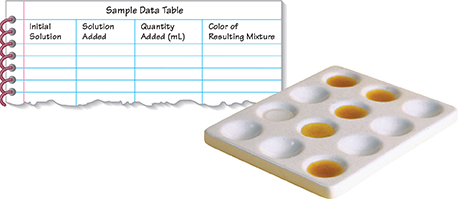
Use the third clean dropper pipet to transfer one drop of colorless iodide solution to a second well on the spot plate.
Use the last clean dropper pipet to add bleach solution to the drop of colorless iodide solution, one drop at a time. Continue until the dark color of the iodine-starch solution reappears. CAUTION Bleach can damage skin and clothing. The chlorine bleach (NaOCl) oxidizes iodide ions (I–), converting them to iodine molecules (I2).
Write a chemical equation showing the equilibrium between iodine molecules and iodide ions. This equation does not need to be balanced. Label the two sides of your equation to indicate which substance appears dark and which appears colorless.
Part B: Design Your Experiment
Predicting Select one of the solutions used earlier that affects the equilibrium between iodine molecules and iodide ions. Record your prediction of the change you will observe in an iodine-starch solution as you add the solution that you selected.
Designing Experiments Design an experiment to test your prediction. Your experimental plan should describe in detail how you will perform your experiment.
Construct a data table like the sample data table shown, in which to record your observations. ( Note: Your data table may not be exactly like the sample data table.)
Perform your experiment only after your teacher has approved your plan. Record your observations in your data table.
CAUTION Wash your hands with soap or detergent before leaving the laboratory.
Analyze and Conclude
Analyzing Data What factor did you investigate? How did it affect the equilibrium between iodine molecules and iodide ions?
Predicting How would you expect the equilibrium to change if you added more iodide ions to the mixture? Explain your answer.
Calculating When chlorine bleach (sodium hypochlorite, NaOCl) oxidizes iodide ions to iodine molecules, sodium hypochlorite is reduced to sodium chloride (NaCl) and water (H2O). Write a balanced chemical equation for this reaction, beginning with the reactants sodium hypochlorite, iodide ions, and hydrogen ions (H+).
Drawing Conclusions How does the addition of more product affect the chemical equilibrium of a reaction?
Go Further
Design an experiment to determine whether other substances that are easily oxidized or reduced, such as iron ions, can reduce iodine to iodide, or oxidize iodide to iodine. Then, with your teacher's approval and supervision, perform your experiment.




